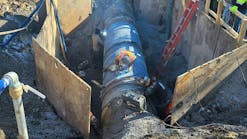Eliminating the Wave of Destruction
While delivering constant pressure is the CSV’s primary job, its design offers users other benefits as well. The consistent delivery from the opening and closing mechanical valve eliminates the transient pressure waves, which Cary Austin, the inventor and owner of Cycle Stop Valves (CSV) headquartered in Lubbock, TX, says are created when a pump starts and stops and the jolting energy causes water hammer. “When things are in motion they want to stay in motion,” he explains.
“These transient pressure waves travel from 3,000–8,000 feet per second, and a pressure tank tries to catch these waves after they happen; but, it’s too little too late and is something like trying to catch a bullet with your teeth. When these waves encounter tees or a 90 degree turn they don’t like it, and this can cause joints to break.”
Eliminating the Wave of Destruction While delivering constant pressure is the CSV’s primary job, its design offers users other benefits as well. The consistent delivery from the opening and closing mechanical valve eliminates the transient pressure waves, which Cary Austin, the inventor and owner of Cycle Stop Valves (CSV) headquartered in Lubbock, TX, says are created when a pump starts and stops and the jolting energy causes water hammer. “When things are in motion they want to stay in motion,” he explains. “These transient pressure waves travel from 3,000–8,000 feet per second, and a pressure tank tries to catch these waves after they happen; but, it’s too little too late and is something like trying to catch a bullet with your teeth. When these waves encounter tees or a 90 degree turn they don’t like it, and this can cause joints to break.” [text_ad] Austin says he is familiar with utility workers whose entire job description is fixing pipe breaks from water hammer. With the CSV, he says, “The check valve is open only the width of a piece of paper when the pump shuts off, and there is no surging, so there is no water hammer ‘to catch.'” Converting the Skeptics While some are reluctant to embrace the concept of the CSV, one engineer has become a convert to the principle and is enthusiastic about the variety of potential applications. Kiron Brown, P.E. with A.L. Franks Engineering, Texarkana, AR, a professional engineering service with significant expertise in public works projects, says the CSV “could be used anytime you want to maintain a certain pressure of a liquid.” He explains that “Every pump has a head curve, and this matches the amount of water that flows against a known elevation. If a pump turns on and it has to pump [water] up to a 300-foot tower, it has to match what it is supposed to do because they don’t like to operate off that curve. Each pump has a set of conditions for it to be efficient.” “So with the CSV, when they’re wide open and flowing, and the pump is working the way it is designed, the pressure starts to go up.” When it reaches the set pressure of the CSV the valve starts to close and creates an artificial head, which Brown says intuitively seems like it would be hard on the pump, as it would not be operating in its ideal condition. Editor’s Note: In wanting to make sure this article displays adequate objectivity, both the writer and I searched for conflicting opinions but did not find any. So while Water Efficiency magazine is not endorsing the product, we’re presenting the story as it was told to us, beginning with when the writer learned of the valves from a water utility when writing about tank coatings and out of service tanks. We are open to hearing from readers who have expertise with this kind of equipment, and/or personal experiences with these valves. Brown adds that “You design for a certain backpressure that the pump is going to be in most of the time, and when you add the CSV you would think, ‘oh, this is going to burn the motor up,’ as it appears like the valve is wanting it to pump less water than would actually flow. But, this doesn’t happen because the valve is controlled and designed so that it is always flowing, and it is never less than 5 gallons per minute—this allows those pumps to cool and keep working.” Plus, Brown says that “there’s no electrical component; it’s all set on a pressure model and it will close off to not let a lot of water in, and if a lot of water is released, it opens up, but is consistent in pressure.” In one instance, Brown said the CSV was the most economical solution to a water tower that was taken out of service. “I had people tell me it would burn up [the pump] and I actually said the same thing, but after we installed it, I assure you we ran the city water for three months on that valve, the pumps, and the ground tank with no problem—it operated just flawlessly (without a water tower in service).” No Voltage, Longer Life By using the CSV, the city was able to keep its water supply and not have to resort to a popoff valve, losing money and a precious water resource. Brown says if you use a variable-frequency drive (VFD) “they change the frequency of the power to the motor to make it run, which allows it to run slower or faster, but it is dependent on electrical supply.” And Austin adds that by eliminating the inherent problems that are typical of a VFD, the CSV actually increases the life of the pump and every component in the system. “With motors running on pure across-the-line sinusoidal voltage, the CSV eliminates harmonics, voltage spikes, bearing currents, and many other problems associated with VFDs. Moreover, the constant pressure from CSVs eliminates line breaks and is saving millions of gallons of precious fresh water every day.” [text_ad use_post='27751'] With so many cities suffering from aging infrastructure, saving water from broken lines is crucial. Austin says that some municipal systems are losing as much as 50% of water from leaks and breaks that he asserts are in large part the result of pumps cycling and causing years of constant water hammer. But fixing the leaks “without fixing the cycling—the source of the problem—is literally like throwing money down the drain.” Brown also envisions being able to use the CSV on projects such as irrigation where a system that provides water to another system is located “a pretty good distance away.” In this instance he describes how pumps can cause a lot of vibration in the long-distance lines but if the CSV were in use, “the pumps wouldn’t kick on and off, hammering with full flow, and water pressure and flow would match usage.”Austin says he is familiar with utility workers whose entire job description is fixing pipe breaks from water hammer. With the CSV, he says, “The check valve is open only the width of a piece of paper when the pump shuts off, and there is no surging, so there is no water hammer ‘to catch.’”
Converting the Skeptics
While some are reluctant to embrace the concept of the CSV, one engineer has become a convert to the principle and is enthusiastic about the variety of potential applications.
Kiron Brown, P.E. with A.L. Franks Engineering, Texarkana, AR, a professional engineering service with significant expertise in public works projects, says the CSV “could be used anytime you want to maintain a certain pressure of a liquid.” He explains that “Every pump has a head curve, and this matches the amount of water that flows against a known elevation. If a pump turns on and it has to pump [water] up to a 300-foot tower, it has to match what it is supposed to do because they don’t like to operate off that curve. Each pump has a set of conditions for it to be efficient.”
“So with the CSV, when they’re wide open and flowing, and the pump is working the way it is designed, the pressure starts to go up.” When it reaches the set pressure of the CSV the valve starts to close and creates an artificial head, which Brown says intuitively seems like it would be hard on the pump, as it would not be operating in its ideal condition.
Editor’s Note: In wanting to make sure this article displays adequate objectivity, both the writer and I searched for conflicting opinions but did not find any. So while Water Efficiency magazine is not endorsing the product, we’re presenting the story as it was told to us, beginning with when the writer learned of the valves from a water utility when writing about tank coatings and out of service tanks. We are open to hearing from readers who have expertise with this kind of equipment, and/or personal experiences with these valves.
Brown adds that “You design for a certain backpressure that the pump is going to be in most of the time, and when you add the CSV you would think, ‘oh, this is going to burn the motor up,’ as it appears like the valve is wanting it to pump less water than would actually flow. But, this doesn’t happen because the valve is controlled and designed so that it is always flowing, and it is never less than 5 gallons per minute—this allows those pumps to cool and keep working.”
Plus, Brown says that “there’s no electrical component; it’s all set on a pressure model and it will close off to not let a lot of water in, and if a lot of water is released, it opens up, but is consistent in pressure.”
In one instance, Brown said the CSV was the most economical solution to a water tower that was taken out of service. “I had people tell me it would burn up [the pump] and I actually said the same thing, but after we installed it, I assure you we ran the city water for three months on that valve, the pumps, and the ground tank with no problem—it operated just flawlessly (without a water tower in service).”
No Voltage, Longer Life
By using the CSV, the city was able to keep its water supply and not have to resort to a popoff valve, losing money and a precious water resource. Brown says if you use a variable-frequency drive (VFD) “they change the frequency of the power to the motor to make it run, which allows it to run slower or faster, but it is dependent on electrical supply.”
And Austin adds that by eliminating the inherent problems that are typical of a VFD, the CSV actually increases the life of the pump and every component in the system.
“With motors running on pure across-the-line sinusoidal voltage, the CSV eliminates harmonics, voltage spikes, bearing currents, and many other problems associated with VFDs. Moreover, the constant pressure from CSVs eliminates line breaks and is saving millions of gallons of precious fresh water every day.”
With so many cities suffering from aging infrastructure, saving water from broken lines is crucial. Austin says that some municipal systems are losing as much as 50% of water from leaks and breaks that he asserts are in large part the result of pumps cycling and causing years of constant water hammer. But fixing the leaks “without fixing the cycling—the source of the problem—is literally like throwing money down the drain.”
Brown also envisions being able to use the CSV on projects such as irrigation where a system that provides water to another system is located “a pretty good distance away.” In this instance he describes how pumps can cause a lot of vibration in the long-distance lines but if the CSV were in use, “the pumps wouldn’t kick on and off, hammering with full flow, and water pressure and flow would match usage.”



